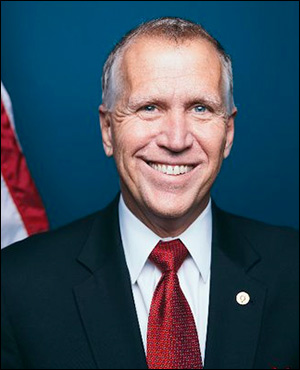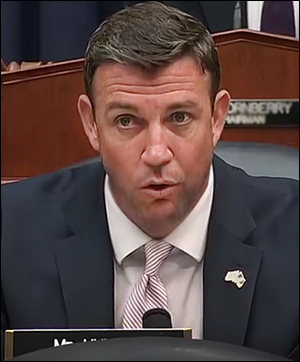
North Carolina Sen. Thom Tillis (R)
Oct. 16, 2019 — A new Meredith College political survey (Sept. 29-Oct. 7; 998 registered North Carolina voters) shows electoral weakness for Sen. Thom Tillis (R) as he seeks a second term next year.
The poll places the first-term US senator in a statistical tie with both of his potential Democratic opponents, state Sen. Erika Smith (D-Gaston) and former state Sen. Cal Cunningham. The large number of uncommitted voters, however, suggests the race could go to either party and will likely break late, similar to many previous North Carolina election results.
According to the Meredith data, Sen. Tillis would tie both Smith and Cunningham with each of the three candidates receiving 33 percent support in all pairings. Obviously, these are not particularly favorable numbers for any incumbent and must be taken more seriously in this instance because of North Carolina’s history of either defeating its senators or seeing them not serve a second term for another reason.
In fact, the only two Tar Heel senators who have been re-elected since 1974 are Jesse Helms (R) and current three-term incumbent Richard Burr (R). During that span, the following senators were no longer in office after one term:
ONE-TERM NORTH CAROLINA SENATORS
- Robert Morgan (D), 1980 – lost re-election
- John East (R), 1986 – committed suicide in June before seeking a second term
- Jim Broyhill (R), 1986 – appointed to fill Sen. East’s term; lost 1986 election)
- Terry Sanford (D), 1992 – lost re-election
- Lauch Faircloth (R), 1998 – lost re-election
- John Edwards (D), 2004 – did not seek a second term to instead run for president
- Elizabeth Dole (R), 2008 – lost re-election
- Kay Hagan (D), 2014 – lost re-election
The Meredith College pollsters also tested Gov. Roy Cooper (D) as he fights for a second term likely against Lt. Gov. Dan Forest (R). Here, Meredith finds the incumbent holding a 46-33 percent margin over his eventual GOP challenger.

 Oct. 9, 2019 — The Civiqs polling firm, as covered in the Daily Kos Elections site, has been testing all 50 states regarding impeachment in a national tracking survey that attracted 150,070 online respondents from May 16 through Oct. 6. The latest numbers suggest that 51 percent of those respondents favor impeaching President Trump, while 45 percent oppose. But, it is in the breakdown of the states’ numbers where the true political story is being told.
Oct. 9, 2019 — The Civiqs polling firm, as covered in the Daily Kos Elections site, has been testing all 50 states regarding impeachment in a national tracking survey that attracted 150,070 online respondents from May 16 through Oct. 6. The latest numbers suggest that 51 percent of those respondents favor impeaching President Trump, while 45 percent oppose. But, it is in the breakdown of the states’ numbers where the true political story is being told.


 By Jim Ellis
By Jim Ellis